Arm Announces Neoverse N1 & E1 Platforms & CPUs: Enabling A Huge Jump In Infrastructure Performance
by Andrei Frumusanu on February 20, 2019 9:00 AM ESTFirst N1 Silicon: Enabling the Ecosystem with SDPs
A little known fact about Arm is that the company designs its own silicon test platform – actually deploying them on development board to enable validation and software development on hardware that Arm and developers have full control of. The latest generation was the Juno platform, which in its first revision started off with a Cortex A57 and served as the fundamental silicon testbed for ARMv8 software.
Ever since Arm started the programme in 2014, Arm has shipped over 1400 boards both internally and to its partners. The amount of chips we’re talking about here sounds paltry, however we have to keep in mind we’re talking about very limited shuttle runs on MPW (multi-project wafers) where Arm shares wafer space with numerous other companies.
For today’s announcement, Arm had the pleasure to reveal that it received back the first working Neoverse N1 silicon back in December – with the chips meant to be integrated into the new Neoverse System Development Platform (SDP).
The N1 SDP represents major step for Arm as it not only is the first silicon to come back with the N1 CPU, but also is Arm’s first own 7nm silicon. The platform represents a major proof of concept of the IP, as well as interoperability with third-party IP, employing a lot of the peripheral IP such as PCIe and DDR PHY supplied by Cadence.
The actual hardware is a limited implementation of an N1 SoC – we find a 4-core N1 CPU with 1MB L2 configuration in the form of 2xMP2 connected to a CMN-600 with an 8MB SLC setup.
The board includes a CCIX compatible PCIe 4.0 x16 slot which serves the crucial role of enabling development and demonstrating cache-coherent integration with CCIX hardware such as Xilinx’s FPGA.
The N1 SoC actually doesn’t contain dedicated I/O IP, rather Arm implements all connectivity via a dedicated FPGA which serves as the I/O hub, supporting various connectivity options such as Ethernet, USB, SATA and so on.
Naturally the big selling point of the SDP is its completely open-source firmware stack from not only the OS drivers, but more importantly the SCP and MCP firmware.
An important new feature that is first employed by the new N1 CPU is the introduction of statistical profiling extensions (SPE). The new extension enables the first ever self-hosted profiling capability in an Arm CPU – meaning we don’t require a separate CPU or system having to read out microarchitectural counters. Instead the new SPE can be configured to directly write this information into memory. The tool is extremely useful for tracing code and analysing core behaviour, identifying possible performance issues and further squeezing out the maximum performance out of a platform, something Arm is taking very seriously if it wants to succeed and gain adoption in HPC.
Finally, the N1 SDP will be available later this quarter – although don’t expect the board to be easily attainable for the average user.


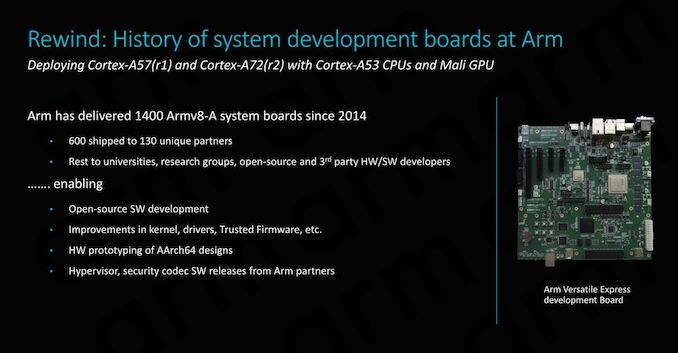
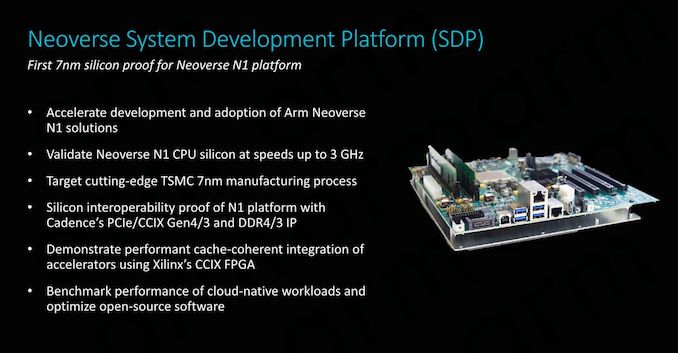
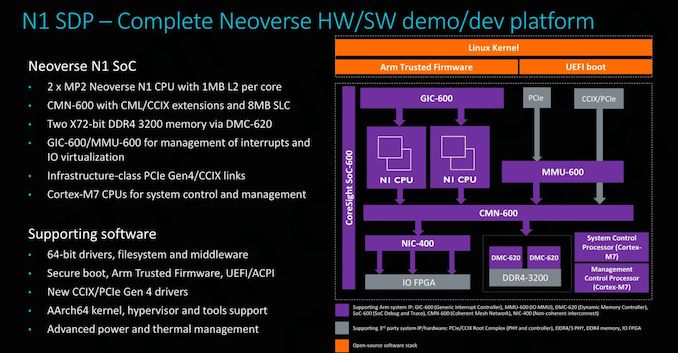
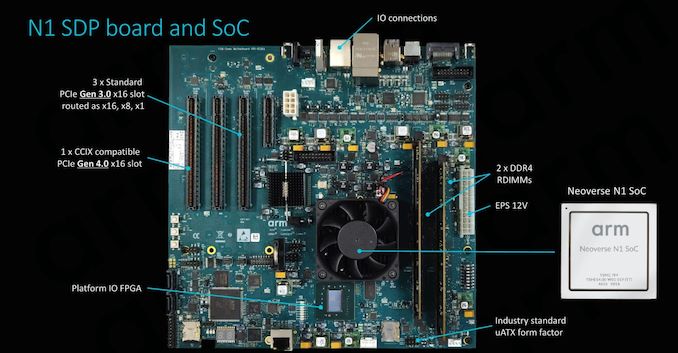

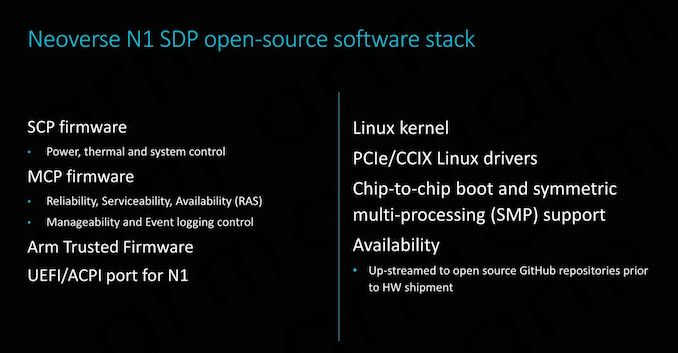

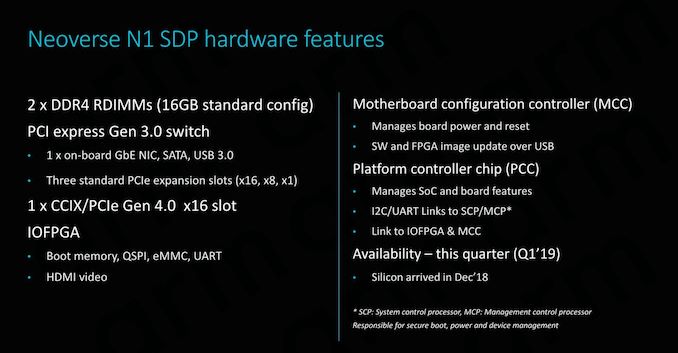








101 Comments
View All Comments
wumpus - Thursday, February 21, 2019 - link
This was supposed to be a reply to "X86 is less efficient than RISC".Neutral - Wednesday, February 20, 2019 - link
"All of these new microarchitectures are important to Arm because they represent an infliction point in the market"...Dictionary result for infliction
/inˈflikSHən/
noun
the action of inflicting something unpleasant or painful on someone or something.
Ryan Smith - Wednesday, February 20, 2019 - link
Whoops, there's one heck of a typo. Thanks!phoenix_rizzen - Thursday, February 21, 2019 - link
There's several other typos, incorrect word usage, and "correctly spelled but incorrect word" errors in this article.Excellent article with a *lot* of great information. But a lot of niggles that should have been picked up by an editor before it was published.
GreenReaper - Wednesday, February 20, 2019 - link
They're bringing *pain* to the competition! :-DAntony Newman - Wednesday, February 20, 2019 - link
Ryan : I think I counted several (6?) typos - a spellcheck will pick up most of them (there was also a DDR related one with a missing letter).AJ
eastcoast_pete - Wednesday, February 20, 2019 - link
@Andrei: Thanks! Sounds very promising, I look forward to ARM-based solutions giving Intel (and AMD) some competitive pressure in the server space, now that SPARC and Power are either down or almost out of this market. Question: Any mention of Microsoft server-type applications being ported to run native on ARM64/Neoverse? That would open a large market for Neoverse and following designs.Other comments: So, did Qualcomm get out of the server market exactly at the wrong time? Sure looks that way. Huawei played it smart, using its development and know-how from the mobile space to make itself a serious contender for ARM-based servers (China's push to have non-US solutions for their home markets doesn't hurt them, either).
The big technical questions for me are: What will the performance and energy use of the CMN-600 mesh network and CCIX be? AMD is trying its chiplet approach, but their first generation had high energy consumption and some performance degradation by the interconnect, which still has them at a disadvantage to Intel's all cores on one die approach. However, scaling up becomes prohibitive as the die gets bigger and transistor counts get higher. I see the interconnect tech as the next big thing for servers and HPC. If they (ARM) and partners can pull this off and be the first with a high-performance, energy-efficient interconnect, they can clobber Intel or AMD just by combining more and more cheap, high-performing cores using chiplets, and do so at a much lower per-core and per-performance cost.
SarahKerrigan - Wednesday, February 20, 2019 - link
Power is not even remotely out of the server market. IBM sells billions of dollars of servers per year, and the top two systems on Top500 are Power.eastcoast_pete - Wednesday, February 20, 2019 - link
Didn't say that Power is completely out of the server market; SPARC is, thanks to Larry. However, while Power is big in HPC and Supercomputing, it's become rare these days to find a Power-based unit in a server closet or rack for more general use, especially outside of large enterprises. IBM also sells quite a number of Intel-based servers, and I believe that accounts for a sizeable chunk of their remaining server business.SarahKerrigan - Wednesday, February 20, 2019 - link
That's not accurate. IBM offloaded their x86 server business (to Lenovo) in 2014. At this point, it is just z mainframes and Power.My company owns a pair of Power systems, one single-socket and one two-socket, and we're pretty small. It's not just large enterprises. OpenPower has brought down entry costs significantly.